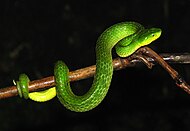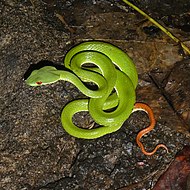Superregnum: Eukaryota
Regnum: Animalia
Subregnum: Eumetazoa
Cladus: Bilateria
Cladus: Nephrozoa
Superphylum: Deuterostomia
Phylum: Chordata
Cladus: Craniata
Subphylum: Vertebrata
Infraphylum: Gnathostomata
Superclassis: Tetrapoda
Cladus: Reptiliomorpha
Cladus: Amniota
Classis: Reptilia
Cladus: Eureptilia
Cladus: Romeriida
Subclassis: Diapsida
Cladus: Sauria
Infraclassis: Lepidosauromorpha
Superordo: Lepidosauria
Ordo: Squamata
Subordo: Serpentes
Infraordo: Caenophidia
Superfamilia: Viperoidea
Familia: Viperidae
Subfamilia: Crotalinae
Genus: Craspedocephalus
Species (15): C. anamallensis – C. andalasensis – C. borneensis – C. brongersmai – C. gramineus – C. macrolepis – C. malabaricus – C. occidentalis – C. peltopelor – C. puniceus – C. rubeus – C. strigatus – C. travancoricus – C. trigonocephalus – C. wiroti
Name
Craspedocephalus Kuhl & Van Hasselt, 1822: 100
Type species: Craspedocephalus puniceus Kuhl, 1824, by subsequent designation (monotypy) by Kuhl (1824: 80).
Synonyms
Peltopelor Günther, 1864: 390
Type species: Trimeresurus macrolepis Beddome, 1862, by monotypy.
References
Primary references
Kuhl, K. & Van Hasselt, J.C. 1822. Uittreksel uit de brieven van Heeren Kuhl en van Hasselt, aan de Heeren C.J. Temminck, Th. van Swinderen en W. de Haan. Algemeene Konst- en Letterbode 7: 99–104. Reference page.
Günther, A.C.L.G. 1864. The Reptiles of British India. Ray Society: London. xxvii + 452 pp. BHL Reference page.
Additional references
Malhotra, A. & Thorpe, R.S. 2004. A phylogeny of four mitochondrial gene regions suggests a revised taxonomy for Asian pitvipers (Trimeresurus and Ovophis). Molecular Phylogenetics and Evolution 32(1): 83–100. DOI: 10.1016/j.ympev.2004.02.008 Paywall Reference page.
Guo, P., Jadin, R.C., Malhotra, A. & Li, C. 2010. An investigation of the cranial evolution of Asian pitvipers (Serpentes: Crotalinae), with comments on the phylogenetic position of Peltopelor macrolepis. Acta Zoologica 91(4): 402–407. DOI: 10.1111/j.1463-6395.2009.00413.x Paywall Reference page.
Malhotra, A., Creer, S., Pook, C.E. & Thorpe, R.S. 2010. Inclusion of nuclear intron sequence data helps to identify the Asian sister group of New World pitvipers. Molecular Phylogenetics and Evolution 54(1): 172–178. DOI: 10.1016/j.ympev.2009.09.007 Paywall Reference page.
David, P., Vogel, G. & Dubois, A. 2011. On the need to follow rigorously the Rules of the Code for the subsequent designation of a nucleospecies (type species) for a nominal genus which lacked one: the case of the nominal genus Trimeresurus Lacépède, 1804 (Reptilia: Squamata: Viperidae). Zootaxa 2992: 1–51. Preview PDF. Reference page.
Guo, P., Liu, Q., Zhong, G.-H., Zhu, F., Yan, F., Tang, T., Xiao, R., Fang, M., Wang, P. & Fu, X. 2015. Cryptic diversity of green pitvipers in Yunnan, South-west China (Squamata, Viperidae). Amphibia-Reptilia 36(3): 265–276. DOI: 10.1163/15685381-00003004 Paywall Reference page.
Boundy, J. 2021. Snakes of the World: A Supplement. CRC Press, Taylor and Francis Group: Boca Raton, Florida. 273 pp. ISBN 9781138618138 ebook Paywall Reference page.
Mallik, A.K., Srikanthan, A.N., Ganesh, S.R., Vijayakumar, S.P., Campbell, P.D., Malhotra, A. & Shanker, K. 2021. Resolving pitfalls in pit viper systematics – A multi-criteria approach to species delimitation in pit vipers (Reptilia, Viperidae, Craspedocephalus) of Peninsular India reveals cryptic diversity. Vertebrate Zoology 71: 577–619. DOI: 10.3897/vz.71.e66239 Open access Reference page.
Links
Uetz, P. & Hallermann, J. 2022. Craspedocephalus . The Reptile Database. Accessed on 4 December 2021.
Craspedocephalus is a genus of venomous pit vipers found in Asia from the Indian Subcontinent to Southeast Asia. Currently 15 species are recognized.
Description
Most species in the genus Craspedocephalus are relatively small, primarily arboreal species, with thin bodies and prehensile tails. Most Craspedocephalus species are typically green in color, but some species also have yellow, black, orange, red, or gold markings.
Feeding
The diet of Craspedocephalus species includes a variety of animals, including lizards, amphibians, birds, rodents, and other small mammals.
Species
| Image | Species | Taxon author | Subsp.* | Common name[1] | Geographic range |
|---|---|---|---|---|---|
| C. anamallensis | (Günther, 1864) | 0 | Malabarian pit viper | India | |
 |
C. andalasensis | David, Vogel, Vijaykumar & Vidal, 2006 | 0 | Indonesia: Sumatra. | |
| C. borneensis | W. Peters, 1872 | 0 | Borneo pit viper | Indonesia: Borneo. | |
| C. brongersmai | Hoge, 1969 | 0 | Brongersma's pit viper | Indonesia: Simalur Island. | |
 |
C. gramineus type species |
Shaw, 1802 | 0 | Common bamboo viper | Southern India. |
 |
C. macrolepis | Beddome, 1862 | 0 | Large-scaled pit viper | The mountains of southern India. |
 |
C. malabaricus | Jerdon, 1854 | 0 | Malabarian pit viper | Southern and western India at 600-2,000 m elevation. |
| C. occidentalis | Pope & Pope, 1933 | 0 | India | ||
| C. peltopelor | Mallik, Srikanthan, Ganesh, Vijayakumar, Campbell, Malhotra, & Shanker, 2021. | 0 | India | ||
 |
C. puniceus | Boie, 1827 | 0 | Ashy pit viper, flat-nosed pit viper | Southern Thailand, West and East Malaysia (Sabah and Sarawak) and Indonesia (Borneo, Sumatra, the Mentawai Islands of Siberut and North Pagai, Simalur and Java. |
 |
C. rubeus | (Malhotra, Thorpe, Mrinalini, & Stuart, 2011) | 0 | Ruby-eyed green pit viper | Cambodia (Mondulkiri), southern Vietnam. |
 |
C. strigatus | Gray, 1842 | 0 | Horseshoe pit viper | The hills of southern India. |
| C. travancoricus | Mallik, Srikanthan, Ganesh, Vijayakumar, Campbell, Malhotra, & Shanker, 2021 | 0 | India | ||
 |
C. trigonocephalus | Donndorff, 1798 | 0 | Ceylon pit viper, Sri Lankan green pit viper | Throughout Sri Lanka from low elevations to about 1,800 m. |
| C. wiroti | Trutnau, 1981 | 0 | Wirot's pit viper | Thailand, West Malaysia. |
*) Not including the nominate subspecies.
References
Gumprecht A, Tillack F, Orlov NL, Captain A, Ryabov S (2004). Asian Pitvipers. First Edition. Berlin: GeitjeBooks. 368 pp. ISBN 3-937975-00-4.
Retrieved from "http://en.wikipedia.org/"
All text is available under the terms of the GNU Free Documentation License

